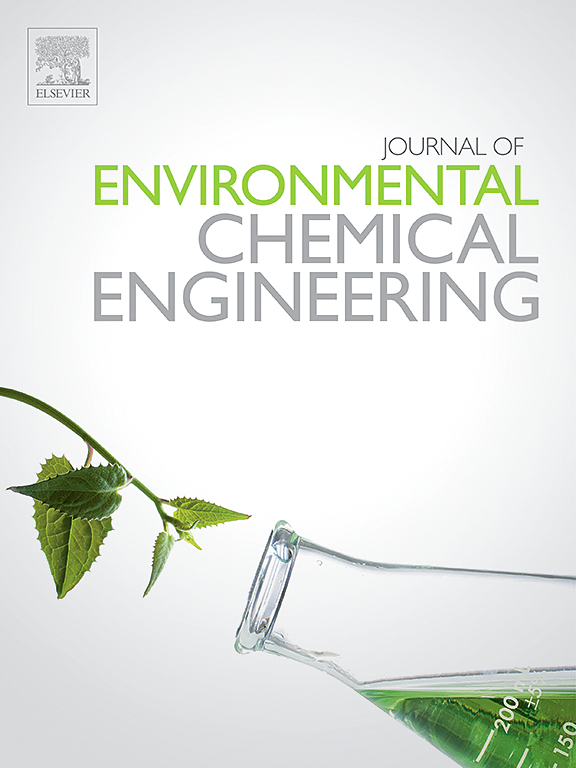Multi-objective optimization of syngas production from bio-glycerol: A bi-reforming approach using NSGA-II
IF 7.4
2区 工程技术
Q1 ENGINEERING, CHEMICAL
引用次数: 0
Abstract
This study investigates the multi-objective optimization (MOO) of syngas production from bio-glycerol using the Non-Dominated Sorting Genetic Algorithm-II (NSGA-II) for constrained optimization in the bi-reforming process. Thermodynamic modelling of the system was conducted in Aspen Plus V12, applying the Gibbs free energy minimization method and accounting for all by-products. Key decision variables, including the water-to-glycerol ratio, CO2-to-glycerol ratio, and reforming temperature, were examined for their impact on process performance. Results demonstrated that bi-reforming glycerol is more advantageous for syngas production compared to dry reforming, as it operates at lower temperatures, reducing coke formation. A glycerol bi-reforming process was simulated and optimized using MOO to maximize syngas production and CO2 conversion while minimizing exergy loss and CO2 emissions. The optimization revealed trade-offs among the objectives, with the Pareto front showcasing optimal solutions. Specifically, a higher water-to-glycerol ratio favoured a higher H2-to-CO ratio but led to decreased CO2 conversion and increased energy consumption and CO2 emissions. The net flow method (NFM) is used to select the best optimal solutions from the Pareto front solutions based on the weight of the objective functions. Despite these trade-offs, bi-reforming of bio-glycerol was shown to be a viable method for producing syngas with a high H2/CO ratio and low CO2 emissions. The best optimal solutions obtained for the bi-reforming of glycerol show an SGR of ∼0.44 and CGR of 1.89, with the reforming temperature of 1202 K giving a CO2 conversion of 42.55 % with exergy efficiency of 78.3 % and syngas production of 6.29 per mole of glycerol having H2/CO ratio of 3.16.
生物甘油合成气生产的多目标优化:采用NSGA-II的双重整方法
本研究利用非支配排序遗传算法(NSGA-II)对双重整过程中的生物甘油合成气进行多目标优化(MOO)。在Aspen Plus V12中对系统进行热力学建模,采用Gibbs自由能最小化方法并考虑所有副产物。关键决策变量,包括水-甘油比、二氧化碳-甘油比和重整温度,对工艺性能的影响进行了研究。结果表明,与干重整相比,双重整甘油更有利于合成气的生产,因为它在较低的温度下操作,减少了焦炭的形成。为了最大限度地提高合成气产量和二氧化碳转化率,同时最大限度地减少火用损失和二氧化碳排放,利用MOO对甘油双重整过程进行了模拟和优化。优化揭示了目标之间的权衡,帕累托前线展示了最优解决方案。具体来说,较高的水-甘油比有利于较高的h2 - co比,但会导致二氧化碳转化率降低,增加能源消耗和二氧化碳排放。基于目标函数的权值,采用净流法从Pareto前解中选择最优解。尽管存在这些权衡,但生物甘油的双重整被证明是一种生产高H2/CO比和低CO2排放合成气的可行方法。结果表明,在1202 K的重整温度下,甘油双重整的SGR为~ 0.44,CGR为1.89,CO2转化率为42.55 %,火用效率为78.3% %,合成气产量为6.29 / mol, H2/CO比为3.16。
本文章由计算机程序翻译,如有差异,请以英文原文为准。
求助全文
约1分钟内获得全文
求助全文
来源期刊

Journal of Environmental Chemical Engineering
Environmental Science-Pollution
CiteScore
11.40
自引率
6.50%
发文量
2017
审稿时长
27 days
期刊介绍:
The Journal of Environmental Chemical Engineering (JECE) serves as a platform for the dissemination of original and innovative research focusing on the advancement of environmentally-friendly, sustainable technologies. JECE emphasizes the transition towards a carbon-neutral circular economy and a self-sufficient bio-based economy. Topics covered include soil, water, wastewater, and air decontamination; pollution monitoring, prevention, and control; advanced analytics, sensors, impact and risk assessment methodologies in environmental chemical engineering; resource recovery (water, nutrients, materials, energy); industrial ecology; valorization of waste streams; waste management (including e-waste); climate-water-energy-food nexus; novel materials for environmental, chemical, and energy applications; sustainability and environmental safety; water digitalization, water data science, and machine learning; process integration and intensification; recent developments in green chemistry for synthesis, catalysis, and energy; and original research on contaminants of emerging concern, persistent chemicals, and priority substances, including microplastics, nanoplastics, nanomaterials, micropollutants, antimicrobial resistance genes, and emerging pathogens (viruses, bacteria, parasites) of environmental significance.
 求助内容:
求助内容: 应助结果提醒方式:
应助结果提醒方式:


